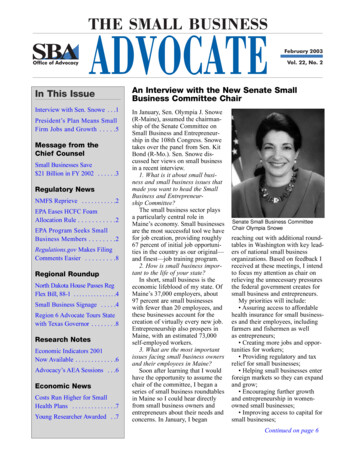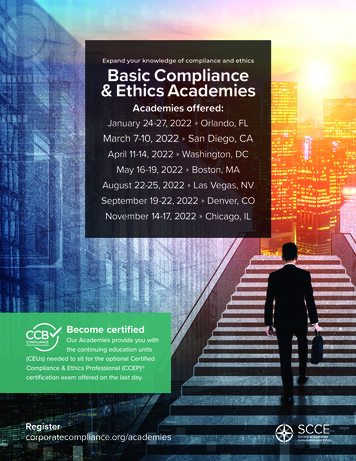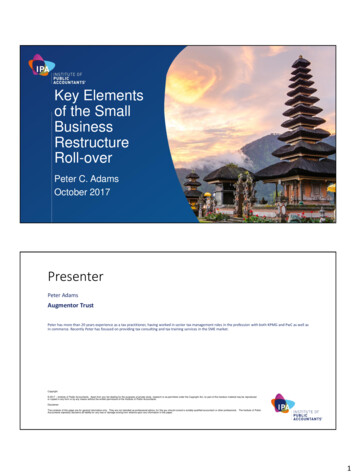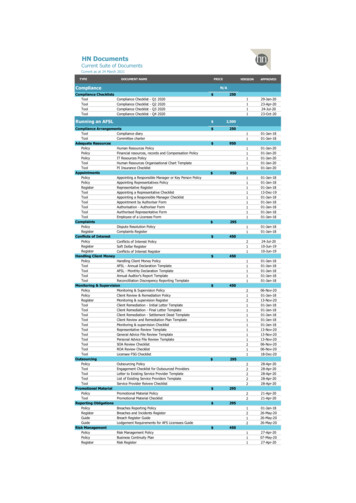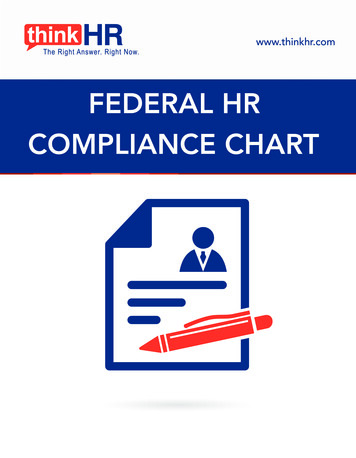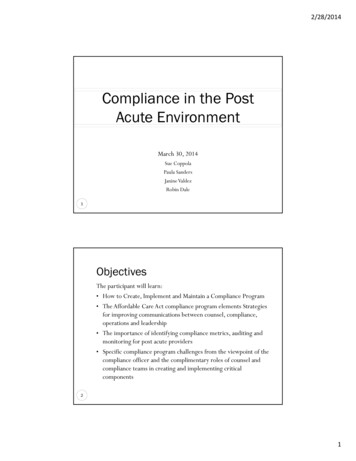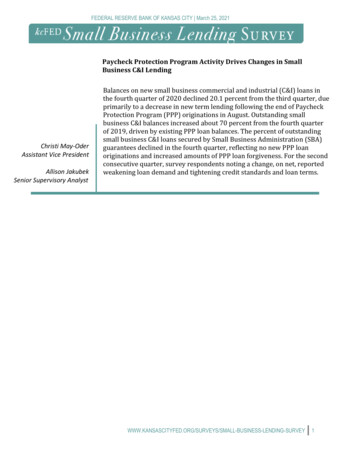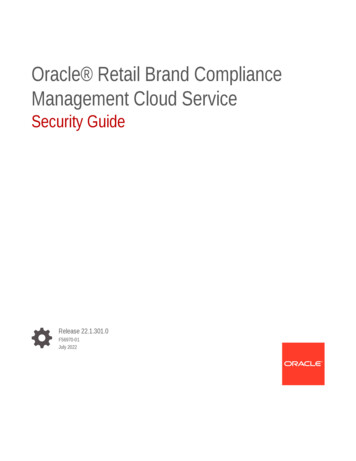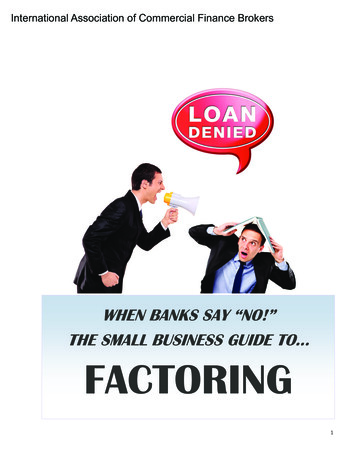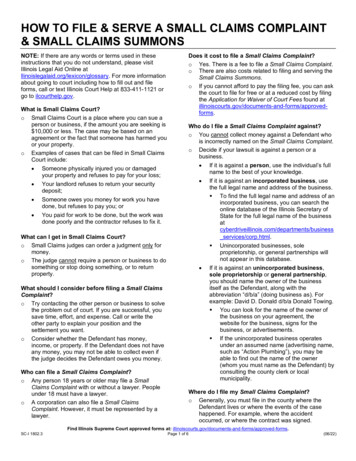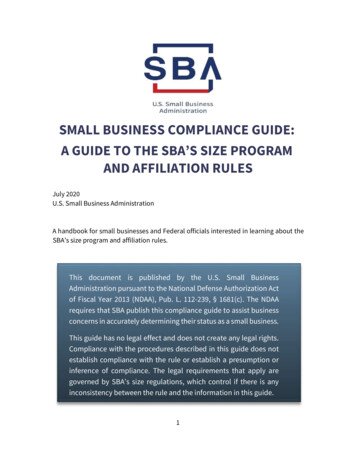
Transcription
SMALL BUSINESS COMPLIANCE GUIDE:A GUIDE TO THE SBA’S SIZE PROGRAMAND AFFILIATION RULESJuly 2020U.S. Small Business AdministrationA handbook for small businesses and Federal officials interested in learning about theSBA’s size program and affiliation rules.This document is published by the U.S. Small BusinessAdministration pursuant to the National Defense Authorization Actof Fiscal Year 2013 (NDAA), Pub. L. 112-239, § 1681(c). The NDAArequires that SBA publish this compliance guide to assist businessconcerns in accurately determining their status as a small business.This guide has no legal effect and does not create any legal rights.Compliance with the procedures described in this guide does notestablish compliance with the rule or establish a presumption orinference of compliance. The legal requirements that apply aregoverned by SBA’s size regulations, which control if there is anyinconsistency between the rule and the information in this guide.1
CONTENTSOVERVIEW1. Why is the issue of a firm’s size important?2. What is NAICS?3. What are size standards?4. Where can current size standards be found?BUSINESS CONCERN1. How does SBA define the term “small business concern”?2. Is a small agricultural cooperative a business concern?3. How must a small business concern be legally organized?4. How are predecessor entities treated?5. Where is the regulatory definition of a “business concern”?AFFILIATION1. How does SBA determine affiliation?2. Where are SBA’s regulations governing affiliation?3. What are the general principles of affiliation?BASES FOR AFFILIATION1. What is affiliation based on stock ownership (13 C.F.R. § 121.103(c))?2. What is affiliation based on stock options, convertible securities, or an agreement tomerge (13 C.F.R. § 121.103(d))?3. What is affiliation based on common management (13 C.F.R. § 121.103(e))?4. What is affiliation based on an identity of interest between individuals or businesses,including family members (13 C.F.R. § 121.103(f))?5. What is affiliation based on the newly organized concern rule (13 C.F.R § 121.103(g))?6. What is affiliation based on common investments or economic dependence (13 C.F.R§ 121.103(a) and (f))?7. When may SBA find affiliation with parties to a joint venture (13 C.F.R. § 121.103(h)(1)and (2))?8. When may SBA find affiliation between a prime contractor and a subcontractor (13C.F.R. § 121.103(h)(4))?9. When may SBA find affiliation as a result of a franchise or license agreement (13 C.F.R.§ 121.103(i))?10. What is affiliation based on the totality of circumstances (13 C.F.R. § 121.103(a)(5))?11. Are there any exceptions to the rules on affiliation (13 C.F.R. § 121.103(b))?SUMMARY OF AFFILIATIONCALCULATING SIZE – RECEIPTS1. How does a firm know if it is small for a receipts-based size standard?2. What if the company has been in business for less than five years?3. Are receipts of affiliates included?4. What if an affiliate is recently acquired?5. What if the affiliate has been in business for less than three years?2
6. What if the business is no longer my affiliate?7. What does SBA mean by the term “receipts”?8. What items are excluded from the definition of “receipts”?9. What document(s) are used to determine a firm’s “receipts”?10. What if a tax return has not yet been filed for a fiscal year?11. What is a “completed fiscal year”?12. Where is the regulation governing a firm’s annual receipts?CALCULATING SIZE – EMPLOYEES1. How does a firm know if it is small for an employee-based size standard?2. Who is considered an employee?3. Are volunteers considered employees?4. Are part-time and temporary employees counted the same as full-time employees?5. What if the firm has been in business for less than a year?6. How is the average number of employees calculated, including affiliates?7. Must the employees of a former affiliate be included in the calculation?8. Where is the regulation governing a firm’s number of employees?FURTHER INFORMATION AND CONTACTS3
OVERVIEW1. Why is the issue of a firm’s size important?In order to be eligible for certain Federal programs and certain Federal contractsand subcontracts, a firm must be a “small business concern.” SBA’s sizeregulations, which are set forth at 13 CFR part 121, are used to determineeligibility for all SBA and Federal programs that require a concern to be small.For example, a business must be small for the following government contractingor business development programs: Small business set-asides; Small Business Innovation Research (SBIR) program; Small Business Technology Transfer (STTR) program; Certificate of Competency (COC) program; Historically Underutilized Business Zone (HUBZone) program; Women-Owned Small Business (WOSB) and Economically DisadvantagedWomen-Owned Small Business (EDWOSB) programs; Service-Disabled Veteran-Owned Small Business (SDVOSB) program; Small business subcontracting; 8(a) Business Development program; and 7(j) Management and technical assistance program.SBA’s size rules also apply to small business loan programs and grant programs.A number of government agencies, including the Food and Drug Administrationand the Department of Veterans Affairs, operate programs for which smallbusiness status is a requirement for eligibility. The size rules apply to theseprograms, as well.2. What is the NAICS?To be considered small, business concerns must meet the size standardassigned to a six-digit North American Industrial Classification System (NAICS)code. The Office of Management and Budget created and is responsible formaintaining and revising these codes. The Census Bureau website contains4
definitions and examples to help businesses determine which NAICS codes bestdescribe their business. Although the system does not have codes for everysingle type of business in the United States, it is remarkably comprehensive andevery business can find a code that describes the kind of business activity inwhich it engages. The government revises the codes every five years/ so a firm’scode(s) may change slightly over time.(NOTE: The Internal Revenue Service uses Principal Business Activity Codes—sometimes known as Principal Business or Professional Activity Codes—whichalso contain six-digits. Although the IRS codes are based on the NAICS, the twosystems are not the same. An IRS code is not the same as an NAICS code andshould never be used to determine a company’s size.)Companies are responsible for choosing their own NAICS codes; the Federalgovernment does not select or assign NAICS codes. A company may have a singleNAICS code or as many NAICS codes as it needs to describe the various types ofeconomic activity it performs. If a company has more than one NAICS code, itmust designate one code as its primary code. Ordinarily/ a firm’s primary NAICScode describes the activity from which it earns most of its revenue.3. What are size standards?A business is considered “small” or “other than small” depending on its sizewhen compared to a size standard. As explained above, SBA assigns a sizestandard to each NAICS code. A business qualifies as a small business concernonly by reference to an NAICS code(s). Most size standards are stated in terms ofeither receipts or employees; in limited cases the size standard is based onsomething other than receipts or employees (e.g., average assets for certainfinancial institutions). SBA determines whether an entity qualifies as a smallbusiness concern by counting its receipts or employees plus the receipts oremployees of all its domestic and foreign affiliates, regardless whether theaffiliates are organized for profit. 13 C.F.R. § 121.103(a)(6).In order to qualify as a small business concern for a particular federalprocurement, a business must meet the size standard that corresponds to theNAICS code assigned to the solicitation and contract. Federal ContractingOfficers are required to assign a NAICS code to every procurement.Example: The Contracting Officer assigns NAICS code 541519, “OtherComputer Related Services,” to a solicitation. NAICS code 541519 has asize standard of 30 million. To be considered a small business for thissolicitation and the resulting contract, the average annual receipts of the5
business plus those of all of its affiliates (if any) must total no more than 30 million. If the total is greater than 30 million, it is not a smallbusiness concern for purposes of this solicitation and contract.(Instructions for calculating receipts are provided below.)SBA reviews size standards on an on-going basis to determine whether theyneed to be adjusted in light of current economic conditions. Federal law alsorequires SBA to review receipts-based size standards at least every five years toadjust them for inflation, if necessary. It is a good practice to consult the Tableof Size Standards from time to time to see whether the size standard(s) for afirm’s NAICS code(s) have been modified.Certain SBA programs have alternative size standards, that is, size standardsother than (or in addition to) those listed in the Table of Size Standards. Forexample, in the Small Business Innovation Research (SBIR) and Small BusinessTechnology Transfer (STTR) programs, the size standard is 500 employeesregardless of NAICS. 13 C.F.R. §121.702(c).In the 7(a) and Development Company Loan Programs, an Applicant businessmay qualify under either the industry small business size standards or thealternative size standard. To qualify under the alternative size standard, theApplicant (including affiliates) must meet the following:a. The maximum tangible net worth may not exceed 15 million; andb. The average net income after Federal income taxes (excluding any carry-overlosses) for the two full fiscal years before the application date may not exceed 5.0 million.Applicants for the Small Business Investment Company (SBIC) program may usethe Table of Size Standards or other net worth and net income standards. 13C.F.R. § 121.301(c). Surety Bond Guarantee assistance requires that anapplicant/ when combined with its affiliates/ meet the size standard “for theprimary industry in which such business concern, combined with its affiliates, isengaged.” 13 C.F.R. § 121.301(d).4. Where can current size standards be found?To help business owners determine whether their businesses are small, SBApublishes a Table of Small Business Size Standards which lists the size standardthat applies to each NAICS code. The current table is based on the 2017 NAICS;the table lists each NAICS code and its assigned size standard. SBA has releaseda size standards tool to help businesses determine whether they qualify as smallfor purposes of Federal contracting.6
The size standards also may be found at 13 C.F.R. § 121.201.The industry-based size standards for purposes of SBA's financial assistanceprograms, excluding the Surety Bond Guarantee assistance program, areincreased by 25% whenever the applicant agrees to use all of the financialassistance within a labor surplus area. (Labor surplus areas are listed monthly inthe Department of Labor publication “Area Trends in Employment andUnemployment.”)BUSINESS CONCERN1. How does SBA define the term “small business concern”?In order to be considered a small business, a concern must first satisfy thedefinition of a “business concern.” A “business concern” is an entity that is: organized for profit, has a place of business located in the United States, and operates primarily within the United Statesormakes a significant contribution to the U.S. economy throughpayment of taxes or use of American products, materials, or labor.A firm must satisfy all three elements of that definition to be considered a“business concern.” A nonprofit organization is not a business concern. Once afirm qualifies as a “business concern/” it must then determine whether it is“small” by selecting the applicable NAICS code and calculating whether itsatisfies the size standard assigned to that code.2. Is a small agricultural cooperative a business concern?A small agricultural cooperative is eligible if it is an association acting pursuantto the provisions of the Agricultural Marketing Act (12 U.S.C. 1141j) and its sizedoes not exceed the size standard established by SBA for other similaragricultural small business concerns. A small agricultural cooperative's membershareholders are not considered to be affiliated with the cooperative simplybecause they are members of the cooperative. However, a business concern orcooperative that does not qualify as small may not be a member of a smallagricultural cooperative.7
3. How must a small business concern be legally organized?A business concern may be organized as an individual proprietorship,partnership, limited liability company, corporation, joint venture, association,trust or cooperative. Where the business is a joint venture, however, there canbe no more than 49% participation by foreign business entities in the jointventure.4. How are predecessor entities treated?A firm and its predecessor entity will be treated as one business concern if asubstantial portion of its assets and/or liabilities are the same. In such a case,the annual receipts and employees of the predecessor will be taken into accountin determining size of the new business concern.5. Where is the regulatory definition of a “business concern”?It is located at 13 C.F.R. § 121.105.AFFILIATION1. How does SBA determine affiliation?Concerns and entities are affiliated with each other when one controls or has thepower to control the other, or a third party or parties controls or has the powerto control both. It does not matter whether the control is exercised, so long asthe power to control exists. 13 C.F.R. § 121.103(a)(1). Affiliation may also befound where one party exercises control indirectly through a third party. 13C.F.R. § 121.103(a)(4). SBA has a specific set of rules that explain when anotherperson, business or entity is considered an affiliate for size purposes.2. Where are SBA’s regulations governing affiliation?SBA’s rules on affiliation for its programs (except SBIR/ STTR/ Business Loans/Disaster Loans, and Surety Bonds) are found at 13 C.F.R. § 121.103. Theregulations are available online at Part 121 of Title 13 of the Code of FederalRegulations (CFR). A firm may also contact any of the points of contact at theend of this document to receive a copy of the rules.For the SBA’s Business Loan/ Disaster Loan/ and Surety Bond programs/ theaffiliation regulation can be found at 13 C.F.R. § 121.301(f). The Business Loanprograms consist of the 7(a) Loan program, the Microloan program, the8
Intermediary Lending Pilot program, and the Development Company Loanprogram (“504 Loan program”). The Disaster Loan programs consist of PhysicalDisaster Business Loans, Economic Injury Disaster Loans, Military ReservistEconomic Injury Disaster Loans, and Immediate Disaster Assistance programloans. Five specific affiliation rules apply to the Business Loan, Disaster Loan,and Surety Bond programs:1) Affiliation based on ownership;2) Affiliation arising under stock options, convertible securities, andagreements to merge;3) Affiliation based on management;4) Affiliation based on identity of interest; and5) Affiliation based on franchise and license agreements.SBA’s affiliation regulations governing the SBIR and STTR programs can befound at 13 C.F.R. § 121.702(c). Information about the specific affiliation rules forthe SBIR and STTR programs, including a compliance guide and FAQs, isavailable at the SBIR webpage.Differences in the treatment of affiliation in these programs are noted below.3. What are the general principles of affiliation?Affiliation exists when one business controls or has the power to control anotheror when a third party controls or has the power to control both businesses.Control may arise through ownership, management, or other relationships orinteractions between the parties.Control may be affirmative or negative. Negative control includes circumstanceswhere a minority shareholder has the ability, under the concern's charter, by laws, or shareholder's agreement, to prevent a quorum or otherwise blockaction by the board of directors or shareholders.9
If SBA determines that affiliation exists, then SBA will count the receipts,employees, or other measure of size for the concern whose size is at issue plusthe receipts, employees, or other measure of size for all of its domestic andforeign affiliates, regardless of whether the affiliates are organized for profit.SBA commonly receives questions about whether affiliation exists. Thefollowing is a summary of SBA’s affiliation rules.BASES FOR AFFILIATION1. What is affiliation based on stock ownership (13 C.F.R. § 121.103(c))?Control of 50% or more of voting stock. A person1 controls or has the power tocontrol an entity if the person owns or controls, or has the power to control, 50%or more of the concern’s voting stock. This is a non-rebuttable basis for findingaffiliation.Example: Company A owns Companies B, C and D (54.5%, 81% and 60%,respectively). Company A has the power to control Companies B, C and D.The companies are all affiliated. The receipts and/or number of employeesof all four companies will be aggregated in determining the size of any oneof them.The term “person” used throughout this document and the regulations includes an individual/ entity/or business concern. 13 C.F.R. § 121.103(c)(1).110
Control of less than 50% voting stock, but large compared to others. If a personowns and controls, or has the power to control, a block of voting stock that islarge compared to all other outstanding blocks of stock (even though itcomprises less than 50% of the voting stock). This is a non-rebuttable basis forfinding affiliation. This basis for affiliation does not apply to the Business Loan,Disaster Loan, and Surety Bond programs.Example 1: Company A owns 40% of the voting stock of Company B and thenext largest share is 2%. Company A controls Company B because it owns thelargest block of voting stock of Company B compared to all otheroutstanding blocks of voting stock. Company A and Company B are affiliates.In addition, all other companies controlled by Company A will be consideredaffiliates of Company B.Example 2: Two individuals each own blocks of shares of Company A. Oneindividual owns 46.67% of the business and the other owns 33.33%. Theindividual that owns 46.67% of the stock owns the largest single block, whichis large compared to any other block, and therefore has the power to controlthe concern. This individual also controls Company B. Company A andCompany B are affiliated.Control of less than 50% voting stock by multiple minority owners. If two or morepersons each own or control (or have the power to control) less than 50% of aconcern’s voting stock and (i) the minority holdings are all approximately equalin size and (ii) all of the minority holdings taken together are large compared toany other stock holdings, each of those persons is presumed to control theentity. However, a person may rebut the presumption by showing that it doesnot have control or the power to control. This basis for affiliation does not applyto the Business Loan, Disaster Loan, and Surety Bond programs.Example: Investor X, Investor Y, and Company A each own 23% of CompanyB. No other stockholder owns more than 5% of Company B. All three personswill be presumed to control Company B. Each presumed affiliate mayattempt to rebut the presumption by showing that its control or power tocontrol does not exist. If the presumption is not overcome, then Company Aand Investors X and Y will all be considered affiliates of Company B. Inaddition, all companies controlled by Company A and Investors X and Ywould be affiliates of Company B.Voting stock is widely held. When a concern’s voting stock is widely held and nosingle block of stock is large as compared with all other stock holdings, the11
business concern’s Board of Directors and Chief Executive Officer (CEO) orPresident are deemed to have the power to control the concern unless evidenceis provided to show otherwise.Example: In a corporation where no one stockholder has a block of votingstock appreciably larger than the others, the concern's Board of Directorsand its CEO or President are considered to control the entity. This means thatany other business controlled by the Board or by the CEO or President is anaffiliate of the business concern in question, unless the Board and CEO orPresident can rebut this presumption.Affiliation for the Business Loan, Disaster Loan, and Surety Bond programs(13 C.F.R. § 121.301(f)(1)). For the Business Loan, Disaster Loan, and Surety Bondprograms, SBA will deem a minority shareholder to be in control if thatindividual or entity has the ability, under the concern's charter, by-laws, orshareholder's agreement, to prevent a quorum or otherwise block action by theboard of directors or shareholders. If no individual, concern, or entity is foundto control based on that test or the 50% test, SBA will deem the Board ofDirectors or President or CEO (or other officers, managing members, or partnerswho control the management of the concern) to be in control of the concern.2. What is affiliation based on stock options, convertible securities, or anagreement to merge (13 C.F.R. § 121.103(d))?SBA treats stock options, convertible securities, and agreements to merge asthough the rights granted have been exercised. SBA gives present effect to anagreement to merge (including an agreement in principle) or to sell stock. Ifthese rights have been granted and they confer the power to control, affiliationexists.Example 1: If Company A holds an option to purchase a controlling interestin Company B, the situation is treated as though Company A had exercisedits rights and had become owner of the controlling interests in Company B.Company A and Company B are affiliates. In addition, all companiescontrolled by Company A will be considered affiliates of Company B.Example 2: Company A and Company B are discussing a potential merger.The companies’ representatives have met several times over the past twomonths. There is neither a formal nor an informal agreement to merge.Unless the two companies have reached an agreement in principle, SBA willnot find affiliation between them based solely upon these open andcontinuing discussions.12
3. What is affiliation based on common management (13 C.F.R. § 121.103(e))?If one or more officers, directors, managing members, or general partners of abusiness concern also control the Board of Directors and/or the management ofanother business concern, the concerns are affiliates.Example 1: Controlling members of Company A’s Board of Directors occupythree out of five positions in Company B’s Board of Directors. The twoconcerns are affiliated because the controlling members of the Board ofDirectors of Company A also control the Board of Directors of Company B. Inaddition, all concerns controlled by Company A will be considered affiliatesof Company B and vice versa.Example 20 A controlling member of Company A’s Board of Directors has vetorights over the majority decisions of Company B’s Board of Directors. Bypossessing such negative control, Company A has control of the Board ofDirectors of Company B and the two concerns are affiliated. In addition, allcompanies controlled by Company A will be considered affiliates ofCompany B and vice versa.The test of common management does not require that the person(s) exercisingthe common management have total control of a concern. Critical influence orthe ability to exercise substantive control over the concern’s operations is alsoa basis for finding affiliation between firms. Persons in senior leadershippositions, such as the CEO and COO, are presumed to exercise substantivecontrol over a firm’s operations/ although they can rebut that presumption byshowing significant evidence to the contrary.In the Business Loan, Disaster Loan, and Surety Bond programs, affiliation alsoarises where a single individual, concern, or entity controls the management ofthe applicant concern through a management agreement.4. What is affiliation based on an identity of interest between individuals orbusinesses, including family members (13 C.F.R. § 121.103(f))?Individuals or firms that have identical (or substantially identical) business oreconomic interests may be treated as one party (i.e., affiliated) unless they candemonstrate otherwise. Family members, persons with common investments,or firms that are economically dependent on each other through contractual (orother) relationships, are presumed to be affiliated. However, individuals or firmsmay seek to demonstrate that no affiliation exists by showing that apparentlyidentical interests are, in fact, separate. Patterns of subcontracting,13
commingling of staff and/or facilities, and other substantial ties maydemonstrate an identity of interest.Example 1: Several officers of Company A are also officers of Company B. Thetwo companies are in the same line of work and extensively subcontract witheach other. The interrelationship between the two companies results inthem acting as one, and therefore they have an identity of interest and areconsidered affiliates.Example 2: Companies A and B share office space and equipment in the samelocation and also share key employees. In addition, Company A has sent asubstantial amount of business to Company B for each of the last three years(which amounts to more than 70% of Company B’s total revenues). All thesefacts, taken together, indicate that the two companies have combined theirresources to each other’s benefit and therefore are affiliatedExample 3: When three of four members of a concern’s Board of Directorshave multiple investments in common with each other outside the concern,they may be viewed as sharing an identity of interest. The three directorswould be deemed to control the Board and to therefore also control thebusiness. Each outside business that these three directors control would bean affiliate of the business concern in question.Example 4: A husband and wife founded an accounting firm in 1974. In 2008,their daughter opened an office supply store using her own funds and a bankloan. Her parents purchase supplies from the daughter’s store/ and sales toher parents represent 10% of the daughter’s revenues. There are no otherbusiness interactions between the daughter and her parents. If there are noother indicia of affiliation, SBA would find the business dealings to beminimal and the presumed affiliation due to family relationships to havebeen rebutted.The presumption of affiliation between family members is limited to marriedcouples, parties to a civil union, parents, children, and siblings.In the Business Loan, Disaster Loan, and Surety Bond programs, affiliation basedupon an identity of interest is limited to close relatives with identical orsubstantially identical business or economic interests. For these programs only,a close relative is defined as a spouse, parent, child, sibling, or the spouse of anysuch person. 13 C.F.R § 120.10.14
5. What is affiliation based on the newly organized concern rule (13 C.F.R §121.103(g))?A new concern is affiliated with an existing concern if:(1) The former (or current) officers, directors, principal stockholders, managingmembers, or key employees of one concern organize a new concern;(2) Both concerns are in the same or related industries or fields of operation;(3) The individuals who organized the new concern serve as the new concern’sofficers, directors, principal stockholders, managing members, or keyemployees; and(4) The one concern is furnishing or will furnish the new concern with contracts,financial or technical assistance, indemnification or bid or performancebonds, and/or other facilities, whether for a fee or otherwise.The presumption of affiliation may be rebutted by showing that there is a clearfracture between the two businesses.Example: The former chief executive officer of Company A organizesCompany B and serves as Company B’s managing member. Companies A andB are in the same or similar industries. Company B receives subcontractsfrom Company A. Company B is affiliated with Company A unless it can showestablish that there is a clear fracture between the two companies.A clear line of fracture exists if the family members have no business relationshipor involvement with each other's business concerns, or the family members areestranged. A clear fracture may be found even if there is a minimal amount ofbusiness between two concerns. Factors that may be relevant in decidingwhether a clear fracture exists include whether the firms share officers,employees, facilities, or equipment; whether the firms have different customersand lines of business; whether there is financial assistance, loans, or significantsubcontracting between the firms; and whether the family members participatein multiple businesses together.This basis for affiliation does not apply to the Business Loan, Disaster Loan, andSurety Bond programs.6. What is affiliation based on common investments or economic dependence (13C.F.R § 121.103(a) and (f))?A concern that is economically dependent upon another person or concern maybe found to be affiliated with that concern. It may also be found affiliated with15
other concerns controlled by the individual or concern on which it is dependent.It may be found affiliated on the basis of control or power to control, an identityof interest, or a combination of these.Affiliation through economic dependence can be presumed where the concernin question derived 70% or more of its receipts from another concern over theprevious three fiscal years. This presumption may be rebutted by showing thatdespite the contractual relations with another concern, the concern at issue isnot solely dependent on that other concern. The presumption may be rebuttedby showing that the concern has been in business for
Computer Related Services," to a solicitation. NAICS code 541519 has a . example, in the Small Business Innovation Research (SBIR) and Small Business Technology Transfer (STTR) programs, the size standard is 500 employees regardless of NAICS. 13 C.F.R. §121.702(c). In the 7(a) and Development Company Loan Programs, an Applicant business .
